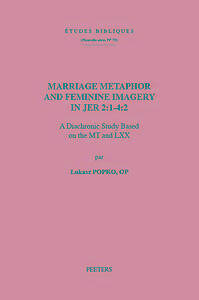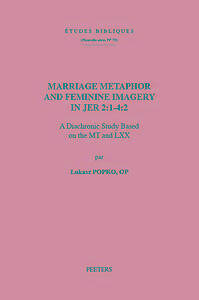
- Afhalen na 1 uur in een winkel met voorraad
- Gratis thuislevering in België vanaf € 30
- Ruim aanbod met 7 miljoen producten
- Afhalen na 1 uur in een winkel met voorraad
- Gratis thuislevering in België vanaf € 30
- Ruim aanbod met 7 miljoen producten
Zoeken
Marriage Metaphor and Feminine Imagery in Jer 2
1-4:2: A Diachronic Study Based on the MT and LXX
L Popko
€ 98,00
+ 196 punten
Omschrijving
Jer 2:1-4:2 is a locus classicus of the prophetic marriage metaphor, which describes the turbulent relationship between Israel and her God. The literary form of the Book of Jeremiah preserved in the Septuagint (LXX) invites a new diachronic study of this text. The systematic, comparative study of the LXX and the Hebrew (MT) makes up a substantial part of the present book (ca. 200 pages). The redaction-critical reconstruction follows the literary form thus retrieved. The edition preserved in the MT introduces the marriage metaphor where the earlier text used general feminine imagery, or suggested rather a filial relationship. The inspiration for the revision came from the Books of Hosea and Ezekiel. The interpretations specific to the translator of the LXX do not point to any coherent agenda. The earliest passage clearly applying the marriage metaphor were introduced at the latest stages of the redaction history. These results demonstrate the growing importance of the marriage metaphor, as well as the ancient editors' conviction about the unity and interconnection of the books which make up the Bible.
Specificaties
Betrokkenen
- Auteur(s):
- Uitgeverij:
Inhoud
- Aantal bladzijden:
- 655
- Taal:
- Engels
- Reeks:
- Reeksnummer:
- nr. 70
Eigenschappen
- Productcode (EAN):
- 9789042934238
- Verschijningsdatum:
- 31/12/2015
- Uitvoering:
- Paperback
- Formaat:
- Trade paperback (VS)
- Afmetingen:
- 160 mm x 239 mm
- Gewicht:
- 1016 g

Alleen bij Standaard Boekhandel
+ 196 punten op je klantenkaart van Standaard Boekhandel
Beoordelingen
We publiceren alleen reviews die voldoen aan de voorwaarden voor reviews. Bekijk onze voorwaarden voor reviews.











